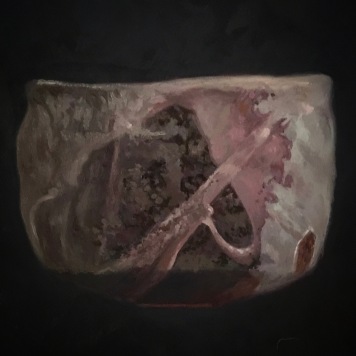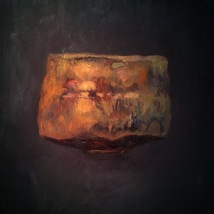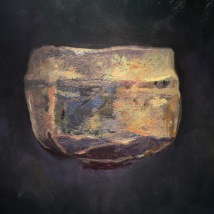Is the way I see more significant than what I’m looking at?



Happy New Year! Returning to the studio after a holiday break requires me to retrace my steps in order to pick up the thread again. I had an idea to study and paint Marc Lancet’s tea bowls. I became committed to this effort. It was fresh and new and bright and exciting, and very challenging. Now I feel like I wander in the twilight, in the woods, in a land of questions. I am blind to where I am going. This place of questions can be a creative place of many possibilities. It can also be uncomfortable. How long and well can I tolerate being lost? I often find myself thinking it is bad to be lost. Is that true?
In spite of the unknowing I continue forward, painting these silent bowls of clay.

The completion of the first large tea bowl collection, the 27-painting group that I think of as a collection of “portraits of emptiness,” left me unclear about where to go next. I’m being led forward by the process, following clues and leads that emerge trying to have faith. As I mentioned in the post from Nov. 16, 2017, I was struck by the way my point of view, literally the height and tilt of my head in relation to the bowl, changed the paintings. There is something important about that. A painting, even a highly “realistic” representational one, is not just a painting of an object but really as much a painting of a point of view. Sometimes the point of view of the artist may be more significant in regards to the meaning of a painting or the experience of the viewer, than the subject itself.
In tea ceremonies I have attended, an important part of the experience of the tea bowl is the way one looks at it. It is as if the wonder of the objects does not dwell just within them but is borne out of a collaboration between the bowl and the viewer. This fascination with the power of view point led me to the next step in this unfolding body of
After experiencing the subtly different points of view in the collection of 27, I decided to paint two sets of nine bowls, 3 foot x 3 foot squares, from completely different points of view. Nine of the bowls I painted looking down into them and nine I painted looking up at them. I chose the shallower bowls to look down into and the ones with steeper walls to look up at.



I was surprised at how powerfully the view affected the “meaning” of, or impact of, the image. Some of the tea bowls are open like an open hand, a flower petal, a shallow pool. The others look closed and impenetrable. Like a tower on a hill or a monument, they look down at me.

Collection of 9 tea bowls, oil on panel, 12″ x 12″
The images gazing into the bowls make me feel welcomed, they are unguarded. There is an offering there, you need only travel into the bowl and it will accept you, enfold you. That point of view is so particular, passive, vulnerable and inviting. It is so different from the bowls that I am looking up at, fortified and impenetrable.

A collection of 9 tea bowls, oil on panel, 12″x 12″
I know that in some sense both have the same kind of beauty but they have a totally different attitude and emotional effect. I think it’s interesting that I say it is their attitude when the difference is, actually, largely my point of view. Every bowl has both an open and a closed aspect and each aspect has a very different character. I can change my art, and life I suppose, by changing the outer “reality” (the subject) or by changing the way I am looking at that “reality”. One could say that in these two collections of paintings, the choice of point of view becomes more powerful than the choice of subject matter.
This is a reminder that I can never separate what I am seeing from the way I am looking at it. And, like with these tea bowls, often my point of view has more influence over my experience of what lies before me than does the thing itself.










